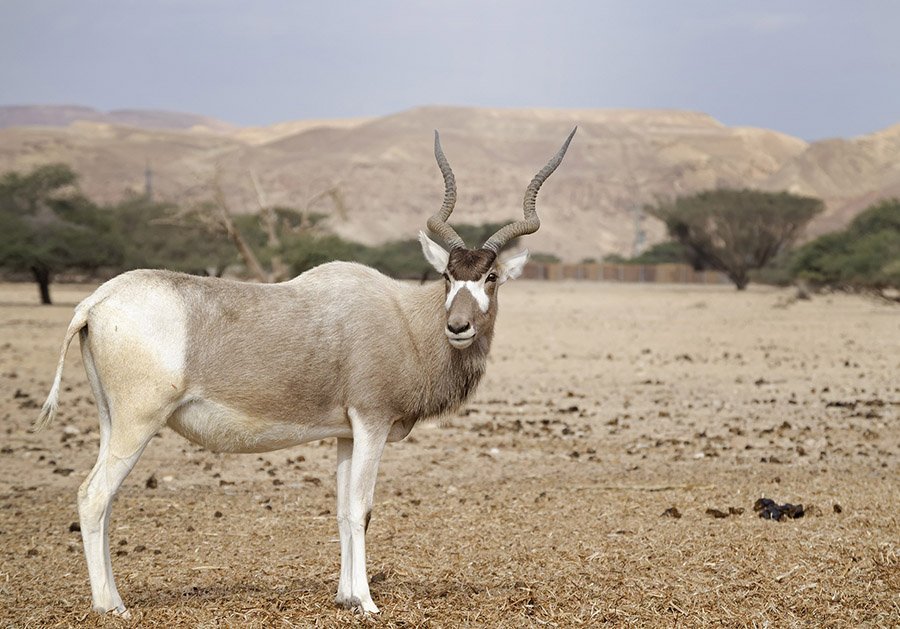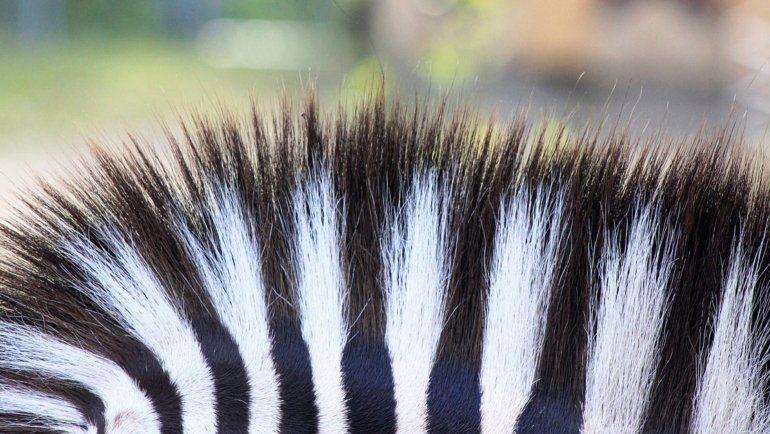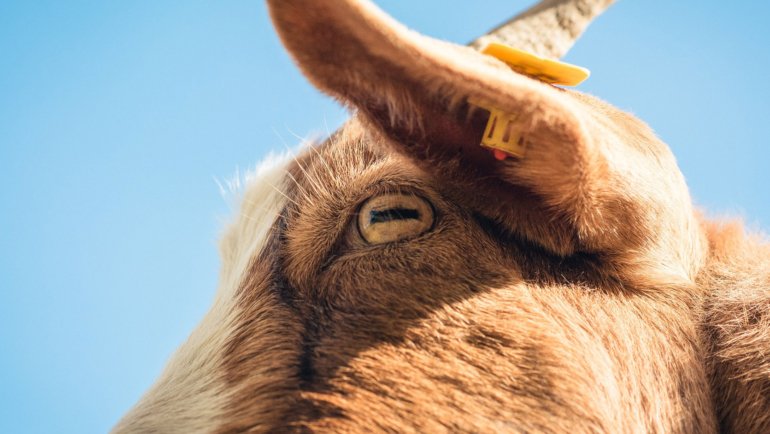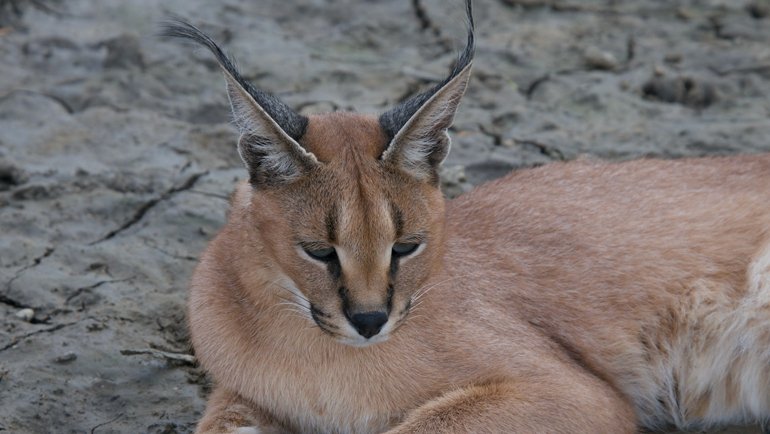Enter the world of the addax, also known as the white antelope or screwhorn antelope. The addax is a critically endangered desert-dwelling member of the antelope family, known for its distinctive spiral-shaped horns and remarkable adaptation to life in some of the harshest conditions on the planet.
Native to the arid regions of the Sahara and the Sahel, the addax plays an important role in maintaining the ecological balance of these regions. As we delve into this guide, we will uncover the unique aspects of the addax’s lifestyle, the challenges it faces, and why its conservation matters.
The Addax at a Glance
Classification
| Kingdom: | Animalia |
| Phylum: | Chordata |
| Class: | Mammalia (Mammals) |
| Order: | Artiodactyla |
| Family: | Bovidae |
| Genus: | Addax |
| Species: | A. nasomaculatus |
Essential Information
| Average Size: | 31 to 43 inches (80-110 cm) at the shoulder |
| Average Weight: | 130 to 280 lbs (59-127 kg) |
| Average Lifespan: | Up to 19 years in the wild |
| Geographical Range: | Sahara Desert |
| Conservation Status: | Critically Endangered (IUCN Red List) |
Species and Subspecies
The Addax (Addax nasomaculatus) is the only species under its genus. It’s unique even within its own family, Bovidae, which includes other antelopes, gazelles, and cattle.
No subspecies of the Addax are recognized. This antelope’s uniqueness lies in its distinct features and exceptional adaptations to desert life, which set it apart from its closest relatives.

Description
The Addax is a medium-sized antelope, standing 31 to 43 inches at the shoulder and weighing between 130 and 280 pounds. One of its most striking features is its pair of long, spiral-shaped horns which can measure up to 3 feet in length. Both males and females bear these horns, making them a distinguishing feature of the species.
The Addax’s coat color changes with the seasons – it is grayish-brown in the winter and almost completely white in the summer, a feature that helps reflect radiant heat. Its white coat, combined with its broad, flat hooves that help it walk on sand, makes it superbly adapted for life in the desert.
As for sexual dimorphism, the differences between males and females are subtle. Both sexes possess horns, but those of the males tend to be thicker and longer. Males are also slightly larger than females.
Habitat and Distribution
Historically, the Addax roamed across a vast stretch of the Sahara and Sahel regions. However, their range has significantly contracted due to habitat loss and hunting. Today, they are primarily found in isolated pockets of the Sahara Desert.
Addax are uniquely adapted to desert life. They can survive in areas of extreme heat and aridity, where most other species can’t survive.
They have a preference for desert terrains, including sandy and stony deserts, and they are often found in areas with greater availability of vegetation. Despite the harsh conditions, Addax have evolved to make the most of their environment and are an integral part of the desert ecosystem.

Behavior
Addax are primarily nocturnal, resting during the day to avoid the extreme desert heat and becoming active during the cooler night hours. They are also crepuscular, being active during the twilight hours of dawn and dusk.
Social Structure
Socially, Addax are gregarious creatures that live in small groups, typically composed of one dominant male and several females with their young.
The groups are generally peaceful, with minimal conflict or aggressive behavior. Males occasionally engage in non-violent displays or pushing matches to establish dominance.
Communication
Communication among Addax is primarily visual and tactile. They communicate their intentions or moods through body postures, facial expressions, and physical contact. Vocalizations are relatively rare, and when they occur, they are usually soft moans or grunts.
Diet and Feeding Behavior
As herbivores, Addax feed on a variety of desert vegetation, including grasses, leaves, and shoots. They have a special fondness for the succulent plants of the desert, which provide them with most of their water needs. This means that Addax can survive without free water almost indefinitely, a crucial adaptation to their arid environment.
Addax are bulk feeders and spend a considerable amount of time foraging for food. Their feeding activity is usually concentrated in the cooler parts of the day, in the early morning and late evening.
Predators
In their natural habitat, adult Addax have few natural predators due to the harshness of their environment. However, young and weak individuals can fall prey to carnivores like lions, hyenas, and leopards.
The primary threat to Addax, however, comes from humans. Overhunting for their meat and hides, along with habitat loss due to expanding agriculture and oil exploration, has led to a severe decline in their population. These human-induced threats pose a much greater risk to Addax’s survival than natural predation.

Reproduction and Life Cycle
Addax are known to breed year-round, but a peak in breeding activity is often observed during the early spring and summer months. The courtship process includes displays from the male, such as tongue flicking and parallel walking.
Following a gestation period of about nine months, the female Addax gives birth to a single calf. Twins are rare. The newborn is able to stand and walk within a few hours of birth, a necessary survival adaptation in the harsh desert environment.
The mother hides her calf for a couple of weeks until it’s strong enough to join the herd. The young Addax are nursed for around 23 to 29 weeks, after which they start to graze on vegetation. They become fully independent at about a year old but may stay with their natal group for several more months or even years.
Conservation and Threats
The Addax is currently listed as Critically Endangered on the International Union for Conservation of Nature (IUCN) Red List. The species has undergone a rapid population decline over the past few decades due to extensive hunting and habitat loss from oil exploration and military activity.
Efforts to protect and conserve the Addax include habitat protection, anti-poaching measures, and captive breeding programs. Numerous zoos around the world participate in a global Addax Species Survival Plan, which aims to maintain a healthy, genetically diverse population of Addax in captivity and to support conservation efforts in the wild.
However, these measures alone are insufficient to secure the future of the Addax. Broader efforts to tackle the root causes of their decline, such as unsustainable development and conflict, are critical to ensuring the survival of this unique desert antelope. Public education and local community engagement are also essential to fostering understanding and support for conservation efforts.
Fun Facts
- Screwhorn Antelope: The addax is sometimes referred to as the “screwhorn antelope” due to its distinctive long, twisted horns, which can grow up to 3 feet in length.
- Desert Adaptations: The addax’s wide, flat hooves prevent it from sinking into the sand, making it an excellent desert navigator. Its coat color changes with the seasons, turning white in the summer to reflect the sun’s heat.
- Water Conservation: The addax can go nearly its entire life without drinking water. It obtains most of its moisture from the plants it eats and minimizes water loss by excreting highly concentrated urine and dry feces.
- Nomadic Lifestyle: Addax are nomadic and often travel up to a few miles each day in search of food.
- Mammalian Compass: An addax always defecates in the same place. These dung piles serve as a sort of compass, helping them navigate their vast desert homes.
Frequently Asked Questions
What do addax eat?
Addax are herbivores and primarily consume grasses and leaves of desert plants, which provide them with the necessary hydration to survive in their arid habitat.
Where can addax be found?
Addax are native to the Sahara Desert. However, their population in the wild has drastically declined, and they are now one of the rarest and most endangered animals in the world.
Are addax fast runners?
Unlike many other types of antelope, addax are not particularly fast or agile. They rely more on their endurance and desert adaptations for survival.
What is the lifespan of an addax?
In the wild, addax can live up to 19 years. In captivity, where they are protected from predators and have a consistent food supply, they can live up to 25 years.
Why are addax critically endangered?
Addax are critically endangered primarily due to overhunting and habitat loss. Their slow speed and predictable habits make them easy targets for hunters, and their desert habitat has been severely impacted by oil exploration and human conflict.





